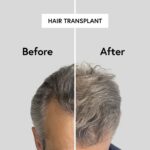Hair transplant surgery is a transformative procedure that can significantly improve a person’s appearance and self-confidence. If you’ve undergone or are planning to undergo a hair transplant in Islamabad, it’s important to understand what happens after the procedure. Knowing what to expect can help you prepare both mentally and physically, ensuring a smoother recovery and optimal results.
Immediate Aftercare: The First 24 to 48 Hours
Once your hair transplant is completed, the healing process begins immediately. During the first 24 to 48 hours, your scalp may be tender, swollen, or slightly red. This is completely normal. Patients are usually given mild painkillers or anti-inflammatory medication to reduce discomfort. It’s crucial to avoid touching or scratching the transplanted area to prevent dislodging grafts.
Your surgeon will also provide specific instructions on how to clean your scalp, usually involving a gentle rinse with mild shampoo and avoiding direct water pressure. You may be asked to sleep in an elevated position to minimize swelling.
To better understand these stages and how long they last, you can review detailed procedures and expectations on the hair transplant page.
The First Week: Healing Begins
During the first week, small scabs may form around each hair graft. It’s essential not to pick at these scabs, as they are a natural part of the healing process. Most of them fall off on their own within 7 to 10 days.
You might also experience some itching on your scalp, which can be managed by staying hydrated and using the recommended products. Follow-up appointments during this period are important to ensure the grafts are healing well.
Patients are usually advised to avoid:
-
Heavy physical activity or exercise
-
Direct sunlight exposure
-
Swimming or getting hair wet beyond instructed limits
-
Wearing hats or tight headwear
Week Two to Four: Shedding Phase
By the end of the second week or into the third week, many patients experience what’s known as “shock loss.” This is when the newly transplanted hairs fall out. While this may seem alarming, it’s a natural part of the process. The follicles remain intact beneath the skin, and new hair growth will begin soon.
During this period, you should continue to follow your surgeon’s instructions, keep your scalp clean, and avoid any hair styling or chemical treatments.
1 to 3 Months Post-Surgery: New Growth Begins
In the first three months, the dormant phase of the hair cycle continues. You may not see visible new growth immediately. However, tiny hairs often start to emerge gradually. Patience is key here, as hair growth is a slow process.
Your scalp may still feel a little numb or tight during this period, but this sensation usually fades over time.
To enhance the quality and speed of new hair growth, many patients in Islamabad opt for PRP hair treatment as a supportive therapy. This non-surgical option can improve blood flow to the scalp and boost healing.
4 to 6 Months: Noticeable Results
This is when many patients start to see visible results. Hair will begin to grow at a steady rate—about half an inch per month. The texture may initially appear fine or wiry, but it will thicken over time.
It’s also the stage where many people begin to feel more confident as they see the transformation taking place. You can start trimming your hair, but any coloring or chemical treatments should still be avoided unless cleared by your surgeon.
6 to 12 Months: Full Growth and Final Results
By the one-year mark, most patients experience full results from their hair transplant. Hair will look natural, full, and blend seamlessly with your existing hair. The density, texture, and overall appearance improve dramatically during this time.
It’s important to attend all scheduled follow-ups to monitor progress and ensure everything is on track. In some cases, if patients desire more density, they may be eligible for a second session.
Tips for Long-Term Care
To maintain the results of your hair transplant:
-
Follow a healthy diet rich in proteins and vitamins
-
Avoid smoking and excessive alcohol
-
Use mild, doctor-approved shampoos
-
Manage stress to avoid hair thinning
-
Keep your scalp clean and hydrated
Additionally, periodic PRP sessions can help strengthen hair and prolong results.
Final Thoughts
A hair transplant in Islamabad offers a reliable and lasting solution for individuals facing hair loss. While the surgery itself is a major step, the recovery period plays a vital role in determining the success of your results. Understanding each stage of the healing process helps set realistic expectations and empowers you to care for your scalp effectively.
To get comprehensive insights about procedures, recovery tips, and long-term results, explore the official hair transplant page. If you wish to accelerate healing and improve hair strength, PRP hair treatment is a valuable addition to your post-transplant care.

